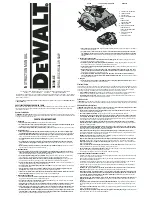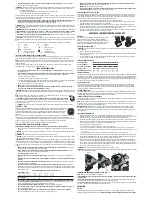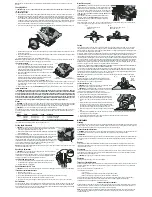
NOTE:
This tool has no provision to lock the switch in the ON position, and should never be locked ON by any other
means.
Changing Blades
CAUTION:
TURN OFF TOOL AND REMOVE BATTERY PACK FROM SAW BEFORE CHANGING ACCESSORIES OR MAK-
ING ANY ADJUSTMENTS.
TO INSTALL THE BLADE
1. Place inner clamp washer (N) on saw spindle spindle with the large flat surface facing out toward the blade (Fig. 4).
2. Retract the lower blade guard (G) and place blade on saw spindle against the inner clamp washer, making sure that
the blade will rotate in the proper direction (the direction of the rotation arrow on the saw blade and the teeth must
point in the same direction as the direction of rotation arrow on the saw). Do not assume that the printing on the blade
will always be facing you when properly installed. When retracting the lower blade guard to install the blade, check the
condition and operation of the lower blade guard to assure that it is working properly. Make sure it moves freely and
does not touch the blade or any other part, in all angles and depths of cut.
3. Place outer clamp washer (O) on saw spindle with the large flat surface against the blade with beveled side facing out.
4. Thread blade clamping screw (H) into saw spindle by hand (screw has left-hand threads and must be turned coun-
terclockwise to tighten).
5. Depress the blade lock (K) while turning the saw spindle with the blade wrench until the blade lock engages and the
blade stops rotating (Fig. 5).
6. Tighten the blade clamping screw firmly with the blade wrench.
NOTE:
Never engage the blade lock while saw is running, or engage in an effort to stop the tool. Never turn the saw on
while the blade lock is engaged. Serious damage to your saw will result.
TO REPLACE THE BLADE
1. To loosen the blade clamping screw (H), depress the blade lock (K) and
turn the saw spindle with the blade wrench until the blade lock engages
and the blade stops rotating. With the blade lock engaged, turn the blade
clamping screw clockwise with the blade wrench (screw has left-hand
threads and must be turned clockwise to loosen).
2. Remove the blade clamping screw (H) and outer clamp washer (O) only.
Remove old blade.
3. Clean any sawdust that may have accumulated in the guard or clamp
washer area and check the condition and operation of the lower blade
guard as previously outlined. Do not lubricate this area.
4. Select the proper blade for the application (see
Blades
). Always use
blades that are the correct size (diameter) with the proper size and shape center hole for mounting on the saw spin-
dle. Always assure that the maximum recommended speed (rpm) on the saw blade meets or exceeds the speed
(rpm) of the saw.
5. Follow steps 2 through 6 under
To Install the Blade
, making sure that the blade will rotate in the proper direction.
LOWER BLADE GUARD
WARNING: The lower blade guard is a safety feature which reduces the risk of serious personal injury. Never use
the saw if the lower guard is missing, damaged, misassembled or not working properly. Do not rely on the lower blade
guard to protect you under all circumstances. Your safety depends on following all warnings and precautions as well
as proper operation of the saw. Check lower guard for proper closing before each use as outlined in Additional Safety
Rules for Circular Saws. If the lower blade guard is missing or not working properly, have the saw serviced before
using. To assure product safety and reliability, repair, maintenance and adjustment should be performed by an autho-
rized service center or other qualified service organization, always using identical replacement parts.
Blades
WARNING:
To minimize the risk of eye injury, always use eye protection. Carbide is a hard but brittle material. Foreign
objects in the work piece such as wire or nails can cause tips to crack or break. Only operate saw when proper saw blade
guard is in place. Mount blade securely in proper rotation before using, and always use a clean, sharp blade.
CAUTION:
Do not cut ferrous metals (steel), masonry, glass or tile with this saw.
A dull blade will cause slow, inefficient cutting overload on the saw motor, excessive splintering, and could increase the
possibility of kickback. Please refer to the table on next page to determine the correct size replacement blade for your
model saw.
Model
Blade
Diameter
Teeth
Application
DC390
DW9155
165mm (6-1/2")
18
General Purpose Cutting
DW9154
165mm (6-1/2")
24
Smooth Wood Cutting
DW9153
165mm (6-1/2")
90
Non-carbide, Plywood/Vinyl Siding Cutting
If you need assistance regarding blades, please call 1800 654 155.
Cutting Depth Adjustment
CAUTION:
Turn off tool and remove battery pack from saw before changing accessories or making any adjustments.
1. Hold the saw firmly and loosen (clockwise) the depth adjustment knob (D) and
move shoe to obtain the desired depth of cut (Fig. 6).
2. Make sure the depth adjustment knob has been retightened (counterclockwise)
before operating saw.
For the most efficient cutting action, set the depth adjustment so that one tooth of the
blade will project below the material to be cut. This distance is from the tip of the tooth
to the bottom of the gullet in front of it. This keeps blade friction at a minimum,
removes sawdust from the cut, results in cooler, faster sawing and reduces the chance
of kickback. A method for checking for correct cutting depth is shown in Figure 7. Lay
a piece of the material you plan to cut along the side of the blade, as shown, and
observe how much tooth projects beyond the material.
NOTE:
When using carbide-tipped blades, make an exception to the above rule and allow only one-half of a tooth to pro-
ject below the material to be cut.
Bevel Angle Adjustment
CAUTION:
Turn off tool and remove battery pack from saw before changing
accessories or making any adjustments.
The full range of the bevel adjustment is from 0˚ to 50˚. The quadrant is graduated
in increments of 1˚. On the front of the saw is a bevel angle adjustment mecha-
nism (Fig. 7) consisting of a calibrated quadrant and a knob (J).
TO SET THE SAW FOR A BEVEL CUT
1. Loosen (counterclockwise) the bevel adjustment knob (J) and tilt shoe to
the desired angle by aligning the pointer with the desired angle mark.
2. Retighten knob firmly (clockwise).
Shoe Adjustment for 90˚ Cuts
CAUTION:
Turn off tool and remove battery pack from saw before changing accessories or making any adjustments.
IF ADDITIONAL ADJUSTMENT IS NEEDED
1. Adjust the saw to 0˚ bevel.
2. Retract blade guard. Place the saw on blade side.
3. Loosen bevel adjustment knob. Place a square against the blade and shoe to adjust the 90˚ setting.
4. Move the adjustment screw so that the shoe will stop at the proper angle.
5. Confirm the accuracy of the setting by checking the squareness of an actual cut on a scrap piece of material.
Kerf Indicator
The front of the saw shoe has a kerf indicator for vertical and bevel cutting. This indicator enables you to guide the saw
along cutting lines penciled on the material being cut. The indicator lines up with the left (outer) side of the saw blade,
which makes the slot or “kerf” cut by the moving blade fall to the right of the indicator. Guide along the penciled cutting
line so that the kerf falls into the waste or surplus material.
FIG. 7
J
D
FIG. 6
TIGHTEN
(counterclockwise)
FIG. 5
K
LOOSEN
(clockwise)
N
O
H
FIG. 4
G
F
L
K
Work Piece Support
WARNING:
It is important to support the work properly and to
hold the saw firmly to prevent loss of control which could cause
personal injury. Figure 8 illustrates proper hand support of the saw.
Maintain a firm grip with both hands on the saw and position your
body and arm to allow you to resist kickback if it occurs. ALWAYS
TURN OFF TOOL AND REMOVE BATTERY BEFORE MAKING ANY
ADJUSTMENTS!
Figure 8 shows proper sawing position. Note that hands are kept
away from cutting area.
To avoid kickback
, DO support board or
panel NEAR the cut (Fig. 9). DON’T support board or panel away
from the cut (Fig. 10).
Place the work with its “good” side – the one on which appearance is most important – down. The saw cuts upward,
so any splintering will be on the work face that is up when you cut it.
Cutting
Place the wider portion of the saw shoe on that part of the work piece which is solidly supported, not on the section
that will fall off when the cut is made. As examples, Figure 8 illustrates the RIGHT way to cut off the end of a board.
Always clamp work. Don’t try to hold short pieces by hand! Remember to support cantilevered and overhanging material.
Use caution when sawing material from below.
Be sure saw is up to full speed before blade contacts material to be cut. Starting saw with blade against material to be cut or
pushed forward into kerf can result in kickback. Push the saw forward at a speed which allows the blade to cut without
laboring. Hardness and toughness can vary even in the same piece of material, and knotty or damp sections can put a heavy
load on the saw. When this happens, push the saw more slowly, but hard enough to keep working without much decrease in
speed. Forcing the saw can cause rough cuts, inaccuracy, kickback, and over-heating of the motor. Should your cut begin to
go off the line, don’t try to force it back on. Release the switch and allow blade to come to a complete stop. Then you can
withdraw the saw, sight anew, and start a new cut slightly inside the wrong one. In any event, withdraw the saw if you must
shift the cut. Forcing a correction inside the cut can stall the saw and lead to kickback.
IF SAW STALLS, RELEASE THE TRIGGER AND BACK THE SAW UNTIL IT IS LOOSE. BE SURE BLADE IS STRAIGHT IN
THE CUT AND CLEAR OF THE CUTTING EDGE BEFORE RESTARTING.
As you finish a cut, release the trigger and allow the blade to stop before lifting the saw from the work. As you lift the
saw, the spring-tensioned telescoping guard will automatically close under the blade. Remember the blade is exposed
until this occurs. Never reach under the work for any reason. When you have to retract the telescoping guard manually
(as is necessary for starting pocket cuts) always use the retracting lever.
NOTE:
When cutting thin strips, be careful to ensure that small cutoff pieces don’t hang up on inside of lower guard.
RIPPING (FIG. 11)
Ripping is the process of cutting wider boards into narrower strips –
cutting grain lengthwise. Hand guiding is more difficult for this type of
sawing and the use of a rip fence is recommended.
POCKET CUTTING (FIG. 12)
CAUTION:
Turn off tool and remove battery pack from saw before
changing accessories or making any adjustments.
CAUTION:
Never tie the blade guard in a raised position. Never move
the saw backwards when pocket cutting. This may cause the unit to
raise up off the work surface which could cause injury.
A pocket cut is one that is made in a floor, wall, or other flat surface.
1. Adjust the saw shoe so the blade cuts at desired depth.
2. Tilt the saw forward and rest front of the shoe on material to be cut.
3. Using the retracting lever, retract lower blade guard to an upward
position. Lower rear of shoe until blade teeth almost touch cutting
line.
4. Release the blade guard (its contact with the work will keep it in posi-
tion to open freely as you start the cut). Remove hand from guard
lever and firmly grip auxilary handle, as shown in Figure 12. Position
your body and arm to allow you to resist kickback if it occurs.
5. Make sure blade is not in contact with cutting surface before starting
saw.
6. Start the motor and gradually lower the saw until its shoe rests flat on the material to be cut. Advance saw along
the cutting line until cut is completed.
7. Release trigger and allow blade to stop completely before withdrawing the blade from the material.
8. When starting each new cut, repeat as above.
MAINTENANCE
Cleaning
Use only mild soap and a damp cloth to clean the tool. Many household cleaners contain chemicals which could seriously
damage plastic. Also, do not use gasoline, turpentine, lacquer or paint thinner, dry cleaning fluids or similar products.
Never let any liquid get inside the tool; never immerse any part of the tool into a liquid.
CHARGER CLEANING INSTRUCTIONS
WARNING:
Disconnect the charger from the AC outlet before cleaning. Dirt and grease may be removed from the exte-
rior of the charger using a cloth or soft non-metallic brush. Do not use water or any cleaning solutions.
Lubrication
Self lubricating ball and roller bearings are used in the tool and relubrication is not required. However, it is recommended that,
once a year, you take or send the tool to a certified service center for a thorough cleaning, inspection, and lubrication of the
gear case.
Repairs
To assure product SAFETY and RELIABILITY, repairs, maintenance and adjustment (including brush inspection and
replacement) should be performed by certified service centers or other qualified service organizations, always using
identical replacement parts.
Accessories
Recommended accessories for use with your tool are available at extra cost from your local service center. If you need
any assistance in locating any accessory, please contact D
E
WALT Industrial Tool Co., 20 Fletcher Road, Mooroolbark,
VIC 3138 Australia or call 1800 654 155.
CAUTION:
The use of any non-recommended accessory may be hazardous.
Guarantee
Applicable to hand held Power Tools, Lasers and Nailers.
Three Year Limited Warranty
D
E
WALT will repair, without charge, any defects due to faulty materials or workmanship for three years from the date of
purchase. Please return the complete unit, transportation prepaid, to any D
E
WALT Service Centre, or any authorised
service station.
For warranty repair information, call 1800 654 155.
This warranty does not apply to
• Accessories
• Damage caused where repairs have been made or attempted by others.
• Damage due to misuse, neglect, wear and tear, alteration or modification.
This warranty gives you specific legal rights and you may have other rights under the provisions of the Consumer
Guarantee Act 1993 (New Zealand only), Trade Practices Act 1974 and State Legislation (Australia only).
In addition to the warranty, D
E
WALT tools are covered by our:
FREE ONE YEAR SERVICE CONTRACT
D
E
WALT will also maintain the tool for free at any time during the first year of purchase. This includes labour, parts and
lubrication required to restore the product to sound mechanical and/or electrical condition. Normal wear parts are not
covered in this service. Carbon brushes worn more then 50% will be replaced.
NOTE:
Three Year Warranty is not applicable to items deemed as consumables. Radial arm saws are covered by a one
(1) year warranty only. D
E
WALT Reserves the right to review its warranty policy prior to launch of any new business
development products.
FIG. 12
INSTALL RIP
FENCE
IN THIS
DIRECTION
FIG. 11
DON’T support board or panel
AWAY from the cut.
FIG. 10
SUPPORT
DO support board or panel
NEAR the cut.
FIG. 9
FIG. 8






















